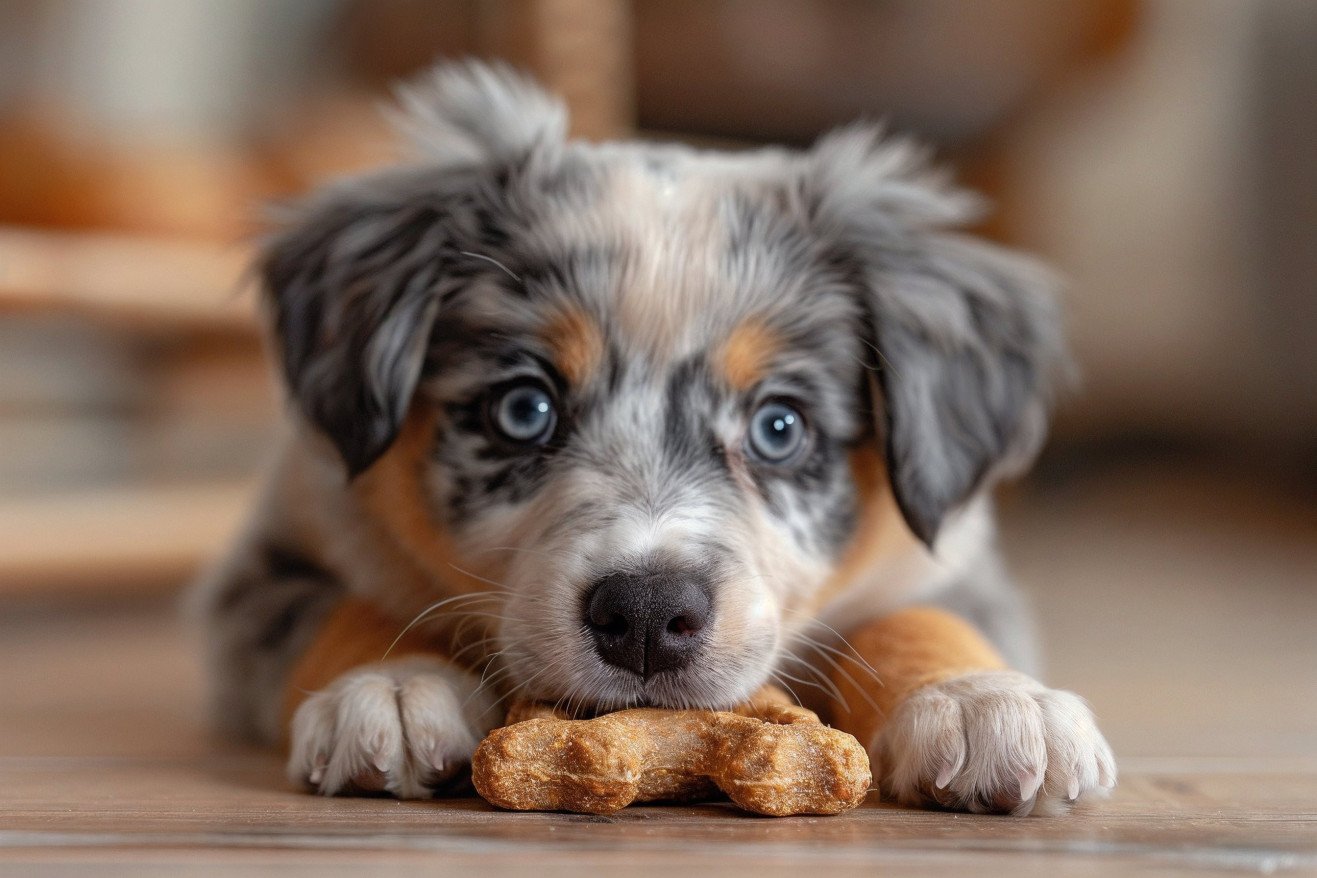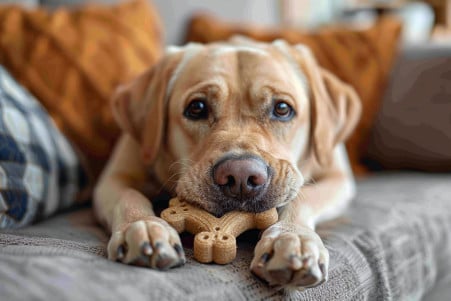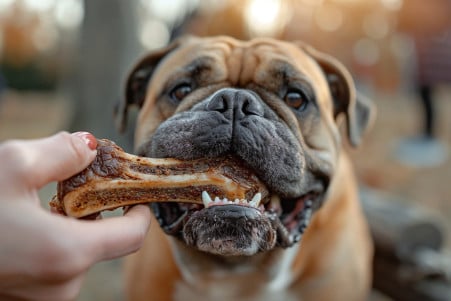Are Nylabones Safe for Dogs? A Look at the Research
5 May 2024 • Updated 4 May 2024

Are nylabones safe for dogs, or do these popular chew toys pose risks like digestive issues or dental problems? Nylabones are generally considered safe for dogs when used as intended - as chew toys for moderate, supervised chewing. However, they can cause problems like broken teeth, obstructions, or blockages if dogs are aggressive chewers who ingest large pieces. Monitor use carefully and choose an appropriate Nylabone size and chewing style for your dog.
To take a closer look at Nylabone safety, we will review veterinary medical research that investigates the potential risks, benefits, and usage recommendations for allowing dogs to chew on these popular chew toys. Through a review of clinical studies and an assessment of dog behavior, we will build a comprehensive picture to help you decide if Nylabones are right for your pet.
Are Nylabones safe for dogs?
Understanding the Risks: Potential Dangers of Nylabones
Nylabones and other hard plastic or nylon chew toys can be dangerous for our furry friends. As Preventive Vet explains, these toys are often too hard on dogs' teeth, which can lead to tooth fractures and other dental problems. The very hardness that makes them long-lasting chew toys can also be harmful to dogs' teeth.
Even more worrisome is the risk of digestive obstruction or blockage if dogs swallow large pieces of Nylabones that have broken off. PetsRadar interviewed veterinarian Dr. Jo Woodnutt, who explained that swallowed pieces can lead to emergency surgery to remove an intestinal obstruction. Even worse, Preventive Vet explains that these indigestible pieces can lead to pancreatitis as the body tries to digest them.
While the claims of Nylabone toxicity or seizure risks are unsubstantiated, the potential for tooth and digestive damage is very real. This is especially true for dogs who are aggressive chewers and who swallow large pieces of toys. This is where supervision and monitoring come into play, as it's important to make sure that dogs don't accidentally swallow pieces of Nylabones that could cause problems.
Safer Alternatives: Other Chew Toy Options for Aggressive Chewers
If your dog is an aggressive chewer or tends to chew off large pieces of their chew toys, Nylabones may not be the best option. According to Dog Lab, chew toys for aggressive chewers must be made of tough materials that can withstand constant chewing, but they also need to be soft enough to protect the dog’s teeth and gums.
This is where alternative chew toys like Goughnuts rings, Furballz balls, Kong Extremes, and Wubba toys come in. These toys are specifically made to meet these requirements. In addition, as The Spruce Pets points out, chew toys made of hard rubber or reinforced fabric are generally safer options for aggressive chewers. The Business Insider article also suggests that dog owners should take into account the toy’s size and material to make sure that it doesn’t pose a choking hazard.
In addition, the study suggests that rotating different types of chew toys and using them for interactive play can help make the toys last longer and keep dogs interested. By offering a range of safe, durable toys, dog owners can meet their pet’s chewing needs while keeping them safe.
Transitioning to Safer Chew Toys: How to Make the Change
If you want to transition your dog away from Nylabones to safer chew toy options, it's important to make the change gradually and with the help of a professional. The Humane Society of the United States explains that you should introduce new toys one at a time, and use positive reinforcement and interactive play to help your dog become interested in the new toy.
Oliver Animal Hospital also recommends rotating different types of toys to keep your dog interested and avoid boredom or destructive chewing. It's also important to supervise your dog when introducing new toys, and to regularly check the toys for signs of damage or wear to ensure they remain safe.
It's important to be patient and stick to the plan, and to reach out to a professional dog trainer or veterinarian if you run into any issues or have any concerns. With the right support and supervision, you can help ensure that the transition to safer chew toys is successful for both you and your dog.
How to Tell When It's Time to Replace a Nylabone
If you choose to keep giving your dog Nylabones, it's important to keep an eye on the condition of the bones and replace them when they show signs of wear and tear. According to SPARK PAWS, two of the most obvious signs that a Nylabone needs to be replaced are if it has shrunk in size and if it has become rough and jagged. If the bone has become small or has an uneven, jagged texture, it's time to replace it.
If a Nylabone is damaged or worn down, it can become a choking hazard or cause harm to your dog's mouth or digestive tract. To make a Nylabone last longer, SPARK PAWS suggests cleaning it regularly, rotating it with other toys, supervising your dog when they play with it, and storing it in a safe place when it's not in use. By getting into the habit of checking and replacing Nylabones, you can help keep your dog safe and prevent potential health problems.
Nylabones and Puppies: Are There Safe Nylabone Options for Teething?
Puppies have different chewing requirements when they are teething, and not all chew toys are created equal when it comes to the safety of a puppy’s developing teeth and gums. While some Nylabones, such as the Nylabone Puppy Teething Ring and Nylabone Dura Chew, are advertised as safe for puppies, the Golden Retriever Dog Forums warns that there are still some potential dangers.
Softer chew toys, such as those made from rubber like Kong toys and cotton-blend rope toys, are recommended as safer options for teething puppies by Kahoots. Edible chews, such as bully sticks or rawhide alternatives, can also help with teething but should be given to puppies with caution and only when they can be monitored.
It’s important to talk to a vet or professional dog trainer to find the best and safest chew toys for your puppy. By doing so, you can make sure that you are keeping your puppy safe and comfortable as they go through the teething process.
Conclusion: Keeping Your Dog Safe While Using Chew Toys Responsibly
Nylabones can be safe chew toys for dogs if they are used as directed and with proper supervision, but they also come with potential dangers that should be taken seriously. If your dog is an aggressive chewer or has a tendency to swallow large pieces, it may be best to opt for safer chew toys that are made of materials like rubber or reinforced fabric. No matter what type of chew toy you select, it's important to keep an eye on your dog's chewing habits, check toys for damage on a regular basis, and replace them as soon as they start to show signs of wear or become unsafe.
Working with a veterinarian or professional dog trainer can help you determine the best and safest chew toys for your dog's unique needs. By keeping your dog's safety in mind and being a responsible pet owner, you can ensure that chew toys continue to be a fun and enriching addition to your dog's life rather than a potential danger.


